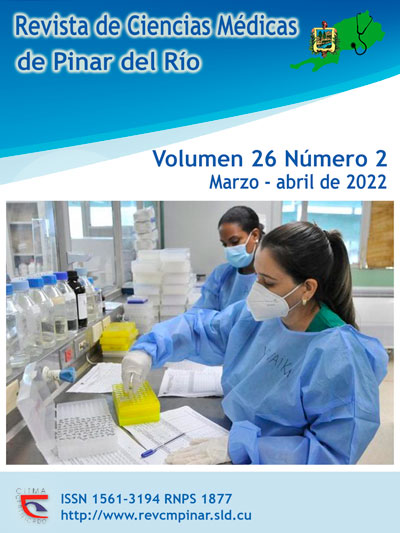Cockayne syndrome: a case report
Keywords:
COCKAYNE SYNDROME, AGING, PREMATURE, POSTNATAL.Abstract
Introduction: Cockayne syndrome is a genetic multisystem disease of rare frequency, characterized by postnatal growth retardation causing short stature, reduction of the generalized adipose panniculus with premature aging appearance, thin skin that allows appreciating capillary circulation, with photosensitivity lesions, progressive neurological dysfunction with intellectual disability.
Case report: a male patient with growth arrest since the age of four, decrease of adipose panniculus more accentuated in the extremities, with globular abdomen with hepatomegaly and vascular spiders; very thin skin with multiple hyperpigmented and hypopigmented spots caused by trauma, atrophic and photosensitive lesions, along with thin depigmented and brittle hair. The patient was assessed by a multidisciplinary team, and after several studies, an exhaustive physical dysmorphological examination was conducted, throughout the clinical method that allowed the delineation of the phenotype, achieving the definitive diagnosis.
Conclusions: it is considered of great value an exhaustive physical examination that allows to correctly delineating the phenotype; without disregarding the importance of a thorough interrogation that facilitates the creation of the genealogical tree that reveals the relationship of all its members. During the study of these low frequency diseases with clinical and genetic heterogeneity, the intervention of a multidisciplinary team is necessary to achieve an accurate clinical diagnosis through the clinical method.
Downloads
References
1. Panchintsev A, Costanzo F, Rauschendorf MA, Caputo M, Ye T, Donnio LM, et al. Cockayne's Syndrome A and B Proteins Regulate Transcription Arrest after Genotoxic Stress by Promoting ATF3 Degradation. Mol Cell [Internet]. 2017 [Citado 02/09/2021]; 68(6): 1054-1066.e6. Disponible en: https://www.sciencedirect.com/science/article/pii/S1097276517308444?via%3Dihub
2. Iyama T, Okur MN, Golato T, McNeill DR, Lu H, Hamilton R, et al. Regulation of the Intranuclear Distribution of the Cockayne Syndrome Proteins. Sci Rep [Internet]. 2018 Nov 30 [Citado 02/09/2021]; 8(1): 17490. Disponible en: https://www.ncbi.nlm.nih.gov/pmc/articles/PMC6269539/
3. Sowmini PR, Kumar MS, Velayutham SS, Revathy G, Arunan S. Cockayne syndrome in siblings. Neurol India [Internet]. 2018 Sep-Oct [Citado 02/09/2021]; 66(5): 1488-1490. Disponible en: https://www.neurologyindia.com/article.asp?issn=0028-3886;year=2018;volume=66;issue=5;spage=1488;epage=1490;aulast=Sowmini
4. Alupei MC, Maity P, Esser PR, Krikki I, Tuorto F, Parlato R, et al. Loss of Proteostasis Is a Pathomechanism in Cockayne Syndrome. Cell Rep [Internet]. 2018 May 8 [Citado 02/09/2021]; 23(6): 1612-1619. Disponible en:
https://www.sciencedirect.com/science/article/pii/S2211124718305850?via%3Dihub
5. Cocco A, Calandrella D, Carecchio M, Garavaglia B, Albanese A. Adult diagnosis of Cockayne syndrome. Neurology [Internet]. 2019 Nov 5 [Citado 02/09/2021]; 93(19): 854-855. Disponible en: https://n.neurology.org/content/neurology/93/19/854.full.pdf
6. Chebly A, Corbani S, Abou Ghoch J, Mehawej C, Megarbane A, Chouery E. First molecular study in Lebanese patients with Cockayne syndrome and report of a novel mutation in ERCC8 gene. BMC Med Genet [Internet]. 2018 Sep 10 [Citado 02/09/2021]; 19(1): 161. Disponible en: https://www.ncbi.nlm.nih.gov/pmc/articles/PMC6131905/
7. He C, Sun M, Wang G, Yang Y, Yao L, Wu Y. Two novel mutations in ERCC6 cause Cockayne syndrome B in a Chinese family. Mol Med Rep [Internet]. 2017 Jun [Citado 02/09/2021]; 15(6): 3957-3962. Disponible en: https://www.ncbi.nlm.nih.gov/pmc/articles/PMC5436194/
8. Calmels N, Botta E, Jia N, Fawcett H, Nardo T, Nakazawa Y, et al. Functional and clinical relevance of novel mutations in a large cohort of patients with Cockayne syndrome. J Med Genet [Internet]. 2018 May [Citado 02/09/2021]; 55(5): 329-343. Disponible en: https://pubmed.ncbi.nlm.nih.gov/29572252/
9. Kou Y, Shboul M, Wang Z, Shersheer Q, Lyu Z, Liu P, et al. Novel frame shift mutation in ERCC6 leads to a severe form of Cockayne syndrome with postnatal growth failure and early death: A case report and brief literature review. Medicine (Baltimore) [Internet]. 2018 Aug [Citado 02/09/2021]; 97(33): e11636. Disponible en: https://www.ncbi.nlm.nih.gov/pmc/articles/PMC6112894/
10. Patel R. Genetic Diagnosis of Cockayne Syndrome. Pediatr Neurol Briefs. 2020 Dec 2; [Citado 02/09/2021]; 34:9. Disponible en: https://www.ncbi.nlm.nih.gov/pmc/articles/PMC7713631/pdf/pnb-34-9.pdf
11. Wang S, Min Z, Ji Q, Geng L, Su Y, Liu Z, et al. Rescue of premature aging defects in Cockayne syndrome stem cells by CRISPR/Cas9-mediated gene correction. Protein Cell [Internet]. 2020 Jan [Citado 02/09/2021]; 11(1):1-22. Disponible en: https://www.ncbi.nlm.nih.gov/pmc/articles/PMC6949206/
12. Spyropoulou Z, Papaspyropoulos A, Lagopati N, Myrianthopoulos V, Georgakilas AG, Fousteri M, et al. Cockayne Syndrome Group B (CSB): The Regulatory Framework Governing the Multifunctional Protein and Its Plausible Role in Cancer. Cells [Internet]. 2021 Apr 10 [Citado 02/09/2021]; 10(4): 866. Disponible en: https://www.mdpi.com/2073-4409/10/4/866
13. Okur MN, Fang EF, Fivenson EM, Tiwari V, Croteau DL, Bohr VA. Cockayne syndrome proteins CSA and CSB maintain mitochondrial homeostasis through NAD+ signaling. Aging Cell [Internet]. 2020 Dec [Citado 02/09/2021]; 19(12): e13268. Disponible en: https://www.ncbi.nlm.nih.gov/pmc/articles/PMC7744955/
Downloads
Published
How to Cite
Issue
Section
License
Authors who have publications with this journal agree to the following terms: Authors will retain their copyrights and grant the journal the right of first publication of their work, which will be publication of their work, which will be simultaneously subject to the Creative Commons Attribution License (CC-BY-NC 4.0) that allows third parties to share the work as long as its author and first publication in this journal are indicated.
Authors may adopt other non-exclusive license agreements for distribution of the published version of the work (e.g.: deposit it in an institutional telematic archive or publish it in a volume). Likewise, and according to the recommendations of the Medical Sciences Editorial (ECIMED), authors must declare in each article their contribution according to the CRediT taxonomy (contributor roles). This taxonomy includes 14 roles, which can be used to represent the tasks typically performed by contributors in scientific academic production. It should be consulted in monograph) whenever initial publication in this journal is indicated. Authors are allowed and encouraged to disseminate their work through the Internet (e.g., in institutional telematic archives or on their web page) before and during the submission process, which may produce interesting exchanges and increase citations of the published work. (See The effect of open access). https://casrai.org/credit/



